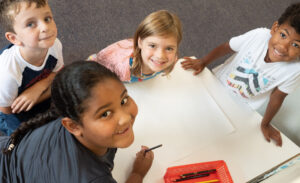 Elementary
Elementary
The Montessori elementary student is not held back by a curriculum of their grade level, but is encouraged to go as far as they are able. The teacher has periodic conferences with each student to help them work effectively in all areas of the curriculum and makes certain that each student is working at a level commensurate with their capabilities. Through the process of discovery, children develop their passion for learning as they grasp the idea that knowledge has no limits.
The Montessori elementary environment accommodates the child’s need to socialize. Each student is free to work where and with whom they choose, and to converse with others sharing information and ideas.
Going Out
“When the child goes out, it is the world itself that offers itself to them. Let us take the child out to show them real things instead of making objects which represent ideas and closing them in cupboards.” – Maria Montessori
Maria Montessori recognized that Elementary children (ages 6-12) are in need of a dual environment: that which is found within the Montessori classroom and that which is found outside the Montessori classroom. While the classroom is captivating and intriguing, it is not enough. Children must witness and experience first-hand what is out in the community. Maria Montessori developed “going out” in an attempt to connect children with the outside world.
Going outs are different than field trips. A true going out trip is one that is thought of, planned, organized, executed, and followed up by the child. These are often small groups of children who are working together on a lesson or research.
A going out can be related to many kinds of work:
Research– A child studying ancient cultures may plan a going out to the Cahokia Mounds with their research group.
Experiments– A child doing an experiment sees they need baking soda and vinegar, so they plan a trip to the store to purchase the items they need.
Care of the Classroom– A child may notice that the classroom is in need of more food for the guinea pig, so they plan a going out to the pet store with a classmate to purchase food.
Community Service– A child may notice that we have extra food left over from a group meal or school picnic. They may decide to look up a local food pantry and arrange an appointment with the food pantry to drop off the extra food.
